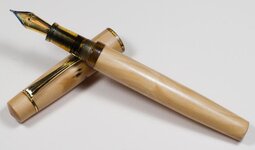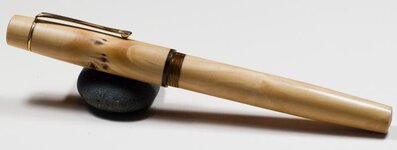dgscott
Member
I bought a number of these blanks from Royal Sandringham from Exotic Blanks. They're not highly figured, but I really like the color (as well as the story -- Yew was used for the English longbow as far back as 4,000 B.C., and a spear was discovered, made from Yew, that was carbon dated at 50,000 years old). This piece has a number of nice brown eyes on both cap and barrel.
The coupling is Ancient Amber lucite.
Thanks, as always, for looking.
Doug
[A little extra conversation for those who miss such things :wink:: Yew (taxus baccata) is toxic (especially the seeds that sit in a cushion of pulpy red flesh that stains everything), but has been used medicinally for some time: as far back as 1021, it was used as a cardiac calcium channel blocker. It is often found planted in churchyards in the U.K. (including the church where my beloved and I were wed 37 years ago), as pre-Christian religious belief held the Yew to be sacred and many pagan holy sites where yews were planted were later conscripted by Christianity.
I've seen some fairly large yews in Britain, but have to admit that my favorite tree is the Major Oak in Sherwood. While Robin of Locksley is said to have married Marion under a yew and been buried under a yew, it is possible that he and the merry men actually gathered under the Major Oak. Even if they didn't, they should have!
Sandringham, in Norfolk, is one of two estates owned privately by the Royal Family (Balmoral being the other). While it was not built by Royals, it was purchased by Queen Victoria in the 1860s. Sitting on approximately 20,000 acres, the estate includes a number of other residences including York Cottage, a "little country house" bigger than some towns in New Mexico.]
The coupling is Ancient Amber lucite.
Thanks, as always, for looking.
Doug
[A little extra conversation for those who miss such things :wink:: Yew (taxus baccata) is toxic (especially the seeds that sit in a cushion of pulpy red flesh that stains everything), but has been used medicinally for some time: as far back as 1021, it was used as a cardiac calcium channel blocker. It is often found planted in churchyards in the U.K. (including the church where my beloved and I were wed 37 years ago), as pre-Christian religious belief held the Yew to be sacred and many pagan holy sites where yews were planted were later conscripted by Christianity.
I've seen some fairly large yews in Britain, but have to admit that my favorite tree is the Major Oak in Sherwood. While Robin of Locksley is said to have married Marion under a yew and been buried under a yew, it is possible that he and the merry men actually gathered under the Major Oak. Even if they didn't, they should have!
Sandringham, in Norfolk, is one of two estates owned privately by the Royal Family (Balmoral being the other). While it was not built by Royals, it was purchased by Queen Victoria in the 1860s. Sitting on approximately 20,000 acres, the estate includes a number of other residences including York Cottage, a "little country house" bigger than some towns in New Mexico.]


